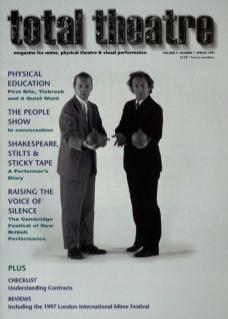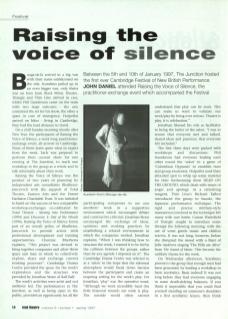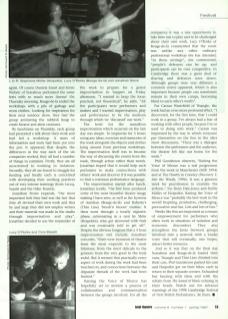Bouge-de-là arrived in a big van with their name emblazoned on the side. Scarabeus pulled up in an even bigger van, only theirs was on loan from Black Mime Theatre. Triangle and Thin Line arrived in cars, whilst Phil Gunderson came on the train with two large suitcases – the one contained the set for his show, the other a spare in case of emergency. Hoipolloi arrived on bikes – living in Cambridge, they had the least distance to travel.
On a chill Sunday morning shortly after New Year, the participants of Raising the Voice of Silence, a week-long practitioner exchange event, all arrived in Cambridge. None of them knew quite what to expect from the week. Each was prepared to perform their current show for one evening at The Junction, to teach one workshop to the group as a whole and to talk informally about their work.
Raising the Voice of Silence was the product of two years of planning by independent arts consultants Bhathena-Jancovich with the support of Total Theatre, Eastern Arts and the Esmee Fairbairn Charitable Trust. It was initiated to build on the success of two comparable workshop-exchanges coordinated by Total Theatre – Moving into Performance (1994) and Discovery 1: Out of the Woods (1996). Raising the Voice of Silence forms part of an overall policy of Bhathena-Jancovich to provide artists with professional development and training opportunities. Chenine Bhathena explains, ‘This project was devised to bring together companies and allow them space and time in which to collectively explore, share and exchange current working processes.’ Cambridge Drama Centre provided the space for the week's exploration and the structure was provided by Jonathan Stone of Ralf Ralf.
The week's activities were artist and not audience led. The performances at The Junction, as well as being open to the public, provided an opportunity for all the participating companies to see one another’s work in a supportive environment which encouraged debate and constructive criticism. Jonathan Stone encouraged the exchange of ideas, opinions and working practices by establishing a relaxed environment in which the companies worked. Jonathan explains: ‘When I was thinking how to structure the week, I wanted it to be led by the collision between the groups, rather than by any agenda I imposed on it.’ The Cambridge Drama Centre was referred to as a 'salon' in the hope that the informal atmosphere would break down barriers between the participants and create an inspiring setting for the week's play. For Jonathan, 'play' was the operative word. ‘Although we work incredibly hard (for little financial reward) our work is play. The outside world often cannot understand that play can be work. This can make us want to validate our work/play by being over serious. Theatre is play, it is celebration.’
Jonathan likened his role as facilitator to being the butler of the salon. ‘I was to ensure that everyone met and talked, shared ideas and practices; that everyone felt included.’
The first three days were packed with workshops and discussions. Phil Gunderson had everyone leading each other round the 'salon' in a game of 'Colombian Hypnosis' to establish trust and group awareness. Hoipolloi used their allocated spot to whip up some material for their forthcoming show Dead on the Ground, which deals with issues of anger and apology. At a refreshing tangent, Thin Line's Richard Talbot introduced the group to Suzuki, the Japanese performance technique. The rigid and precise military-style manoeuvres involved in the technique left many with sore limbs. Carran Waterfield of Triangle sought to introduce some therapy the following morning, with the use of some gentle music and chiffon scarves. It was not long, however, before she disrupted the mood with a blast of Julie Andrews singing 'The Hills are Alive' from The Sound of Music. This became the unlikely theme for the week.
On Wednesday afternoon, Scarabeus proved to the group that enough trust had been generated, by leading a workshop in basic acrobatics. Basic indeed! It was not long before they had everyone engaging in some death-defying balances. If you think it impossible that you could find yourself standing on someone's shoulders in a first acrobatics lesson, then think again. Of course Daniela Essart and Soren Nielsen of Scarabeus performed the same feats with so much more finesse! On Thursday morning, Bouge-de-là ended the workshops with a pile of garbage and worn clothes. Looking for inspiration for their next outdoor show, they had the group animating the rubbish heap to create bizarre and alien creatures.
By lunchtime on Thursday, each group had presented a talk about their work and had led a workshop. A mass of information and work had been put into the pot. It appeared that despite the differences in the way each of the six companies worked, they all had a number of things in common. Firstly, they are all accustomed to working in isolation. Secondly, they all are forced to struggle for funding and finally each is concerned with developing their working practices out of very intense trainings (from Lecoq, Suzuki and the Odin Teatret).
Jonathan Stone expands, ‘the most important link they had was the fact that they all devised their own work and that by and large they did not employ writers and their material was made in the studio through improvisation and play’. Jonathan decided to use the remainder of the week to prepare for a grand improvisation to happen on Friday afternoon. ‘I wanted to keep the focus practical, not theoretical,’ he adds. ‘All the participants were performers and makers and I wanted improvisation, play and performance to be the medium through which we “discussed” our work.’
The brief for the marathon improvisation which occurred on the last day was simple. To improvise for three hours using any ideas, exercises and memories of the week alongside the objects and clothes lying around from previous workshops. The improvisation itself was to become the way of discussing the events from the week, through action rather than words. Jonathan hoped that it would help each performer to make connections with others' work and discover if it was possible to find a common performance language.
The improvisation started after lunch. Jonathan recalls, ‘the first hour produced some of the most beautiful theatre image making I have seen, as well as the hysteria of Aurelian (Bouge-de-là) and Roberto's (Thin Line) 'brush'n broom' routine. It then went through a totally orgiastic phase, culminating in a rant by Shon (Hoipolloi), who got showered with fruit and was eventually told to get off’. Despite the obvious longeurs that a three-hour improvisation will include, Jonathan concedes, ‘there were moments of theatre from the most exquisite to the most hilarious; from the most delicate to the grossest; from the very good to the truly awful. But it seemed that practically every aspect of work during the week had been touched on, and connections between the disparate threads of the week had been formed.’
Raising the Voice of Silence has hopefully set in motion a process of collaboration and communication between the groups involved. For all the companies it was a rare opportunity to take time out to play and to be challenged about their own work. Lucy O'Rorke of Bouge-de-là commented that the event was unlike any other ordinary professional workshop she has attended. ‘In these settings,’ she commented, ‘people's defences can be up, and participants can be over competitive. In Cambridge there was a great deal of sharing and defences were down. Although groups were very different a common centre appeared, which is also important because people can sometimes remain in their own camps, becoming blind to each other's worth.’
For Carran Waterfield of Triangle, the week had an even more profound effect. ‘I discovered, for the first time, that I could work in a group. I've always had a fear of working with other people, because I'm so used to doing solo work.’ Carran was impressed by the way in which everyone put themselves on the line in the after show discussions. ‘There was a dialogue between the performers and the audience, the theatre felt like our home for the week.’
Phil Gunderson observes: ‘Raising the Voice of Silence was a real progression from the week in Manchester (MIP, 1994) and at The Hawth in Crawley (Discovery 1: Out of the Woods, 1996). It was a genuine week for practitioners to examine the artform.’ For Shôn Dale-Jones and Steffie Müller of Hoipolloi, Raising the Voice of Silence was ‘probably the best week in the world! Inspiring, productive, challenging, provocative and fun. Lots and lots of fun.’
Weeks like this are important as a means of empowerment for performers who often work in situations of isolation and economic discomfort. They also strengthen the links between groups involved into a network with a louder voice that will eventually, one hopes, attract better resources.
And so it was that on the final day Scarabeus and Bouge-de-là loaded their vans, Triangle and Thin Line climbed into their cars, Phil Gunderson packed his case and Hoipolloi got on their bikes, each to return to their separate corners. Exhausted but buzzing with ideas and with the refrain from The Sound of Music echoing in their heads. Watch out for advance warnings of the 1998 Cambridge Festival of New British Performance. Be there.


